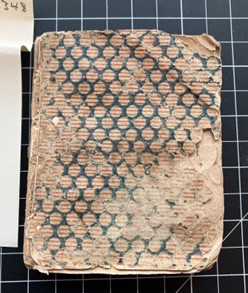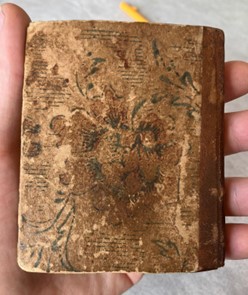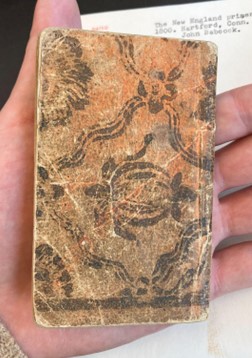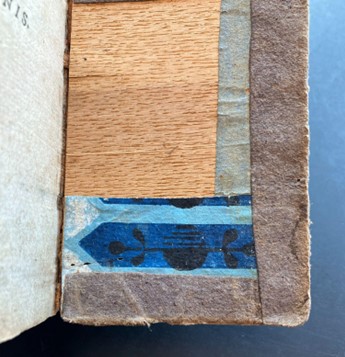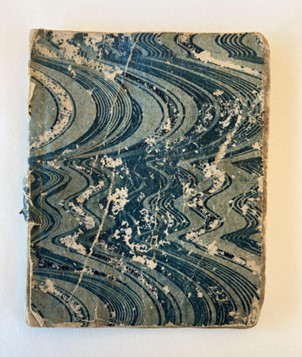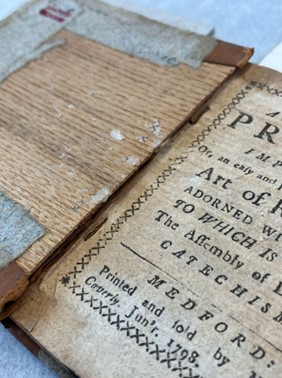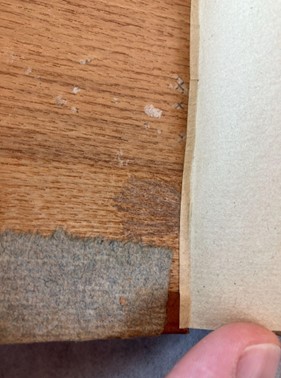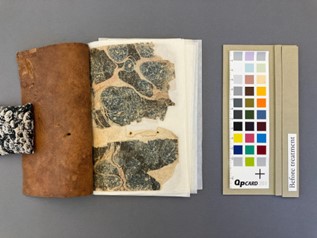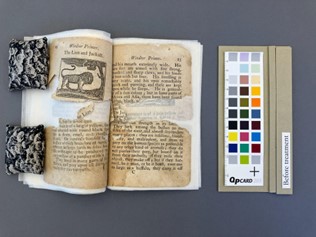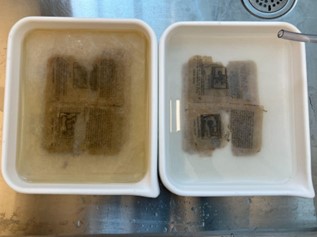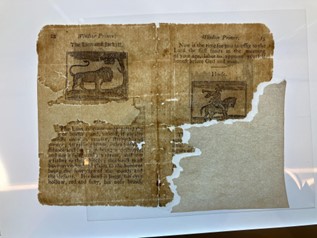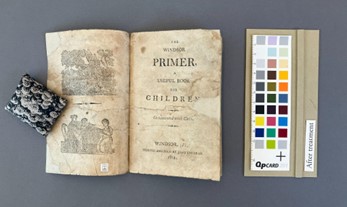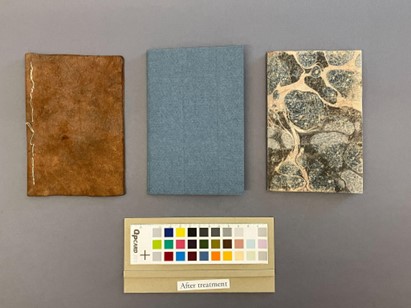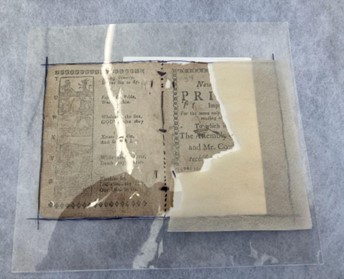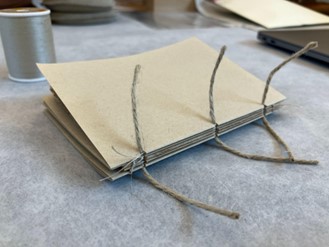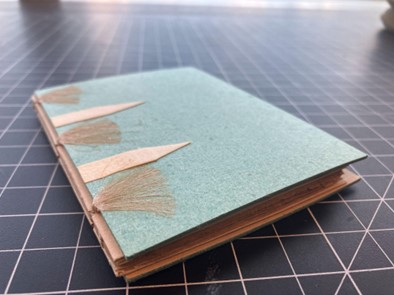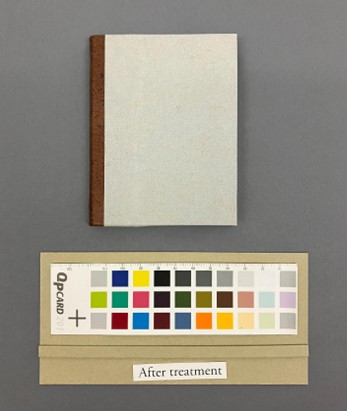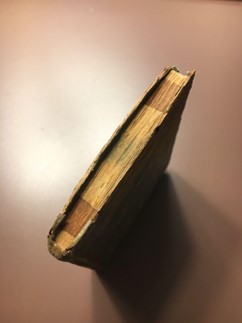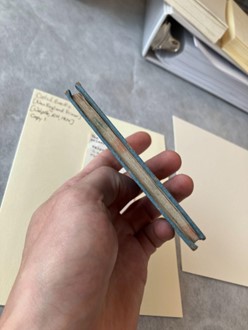In the summer of 2023, while completing my MA in book conservation at West Dean College in Chichester, England, I undertook a 10-week internship at the American Antiquarian Society, working alongside Chief Conservator Babette Gehnrich and Library and Archives Conservator Marissa Maynard. In between my time spent writing a thesis, attending a week-long course on the history of the book in China at the University of Virginia’s Rare Book School, and undertaking pigment identification research at Harvard’s Weissman Preservation Center, Babette and Marissa provided a fantastic opportunity to explore the wealth of the AAS collections and hone my treatment skills in an exceptional lab environment.
Beyond the physical repair of cultural heritage objects, conservation involves the preservation of the intangible values, meanings, and stories embodied by those artifacts. The first step in an effective treatment, then, must be to consider what makes those objects worth preserving. Babette encouraged me to take advantage of AAS’s unique collection of early American printed works and pursue personal research interests in 18th-century decorated papers and book structures. These elements found a happy balance in a short study of one quintessential American publication, The New England Primer.
What is a Primer?
Primers are among the earliest printed schoolbooks developed expressly for children, offering lessons in reading, spelling, and morality. Following some prototypical publications in the 16th century, English printer Benjamin Harris published The Protestant Tutor in 1679, which included woodcut illustrations of the alphabet and several prayers. The positive reception of this publication led Harris to develop a similar work, The New England Primer (NEP), for audiences in the newly established American colonies between 1687 and 1690. This history of the NEP is known only through publishers and booksellers advertisements: no copies of the text dated before 1727 are known to survive, making AAS’s 1727 copy an exceptional treasure indeed.
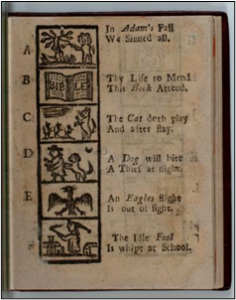
Schoolbooks like the NEP were subject to heavy use and wear as they passed from one generation to the next. The examples that survive today speak to that history. Despite their fragility, the books were cherished — many volumes bear evidence of multiple owners and homespun repairs, decorations, and re-coverings, illustrating the value systems of thrift in which these books were used. Often, it was preferable to make a single copy last as long as possible rather than purchase a new copy when the old one began to break down. These alterations and interventions offer a glimpse into that reality, rendering the bindings (and their damage!) just as valuable as the texts they hold.
Working closely with Babette and Laura Wasowicz, Curator of Children’s Literature, my survey of pre-1821 primers at AAS grew from that mindset: setting aside content, what are these books made of, and what can that information tell us about their place in the book history continuum?
Book Structure Surveys
The study of physical book bindings is one of materiality as well as functionality. How and with what materials a book was made can provide insights into how, when, and by whom it was used. This might be especially true considering the historical focus of bibliographers on highly decorated “extra” bindings and their general dismissal of books without full leather coverings or gold tooling as unfinished or temporary. In truth, these simpler bindings speak to the practical needs and buying power of their intended audience, offering a more inclusive and representative perspective on the way books were used in the 18th and 19th centuries. Material analysis helps to highlight this shift in the role of printed books from the status symbols of the privileged to the cherished tools of a rapidly growing middle-class readership.

One common structure recorded during this survey is the scaleboard binding, a distinctly early American structure which deserves exploration in its own right. Scaleboard bindings are unique in their use of thin (1–3 mm) wooden cover boards nearly two hundred years after the uptake of paper-based paste- and pulpboard in the West. The lack of a developed papermaking industry in the American colonies, the expense of importing paper products from Europe, and the wealth of natural forest resources in the New World made scaleboard economically preferable in the Colonies, but the practice persisted for a variety of reasons through the 1840s. The books are generally quarto size or smaller and bound in full leather before the 1790s, after which time quarter leather with blue or decorated paper sides proliferated. Bindings from the 17th and 18th centuries often hold theological imprints such as sermons, psalms, and religious treatises, but by the turn of the century these bindings are largely associated with schoolbooks and primers.
As utilitarian products, scaleboard and wrapper bindings have been neglected by booksellers and historians focused on the more refined products of contemporary Europe. Only recently has there been a rise in scholarship addressing the important place of these structures in book history, and this burgeoning knowledge base has shown us how much we have yet to learn about American bookbinding. As conservators, we start not by treating objects according to our preconceived ideas, but by letting the objects speak for themselves.
NEP Bibliographic Survey Results
Of the 269 primers surveyed at the American Antiquarian Society, 105 were bound in scaleboard, 97 in paper wrappers, and 32 in paper-based boards. The binding style of 34 textblocks was indiscernible due to extensive damage or rebinding, and the survey turned up a single example of a post-gothic style binding, with wooden boards thicker than those of scaleboard bindings (3–6 mm) and beveled along the head, tail, and fore-edges.
Most scaleboard bindings from this survey were bound in quarter tanned leather with either blue (72 examples), marbled (4), plain (4), or block-printed (1) paper sides. Full leather bindings were the next most popular covering category (11 examples). This survey presented the first recorded example of a full alum-tawed skin covered scaleboard binding (The New England Primer, Boston, 1756). Of particular note is the fact that the AAS copies of both the 1679 Protestant Tutor and the 1727 NEP were originally bound in full leather over scaleboards, though the NEP was sympathetically rebound following extensive conservation treatment in 1997.
Paper wrappers were most popularly plain blue (27), printed blue (13), block-printed (11), marbled (11), plain (10), and brocade (Dutch gilt) (6). The rarer types of decorated paper from this survey, including paste paper, sprinkled paper, and flocked wallpaper, also survive as wrappers. While most of the surveyed wrapper bindings held imprints dated after 1780, this could be attributed to a limited survival of these fragile structures as well as to contemporary production trends.
Primer Treatments at AAS
During this bibliographic research, I did my own bit of work to keep these objects accessible, contributing to their physical history by recognizing and preserving them. The following three treatments demonstrate the various forms this work can take:
1798 American Primer: Ramieband Board Re-attachment
As dictated by conservation standards, treatments are generally minimized to the greatest extent possible, with the primary focus of the work being not on restoration but on facilitating access, whatever that might mean. In one case, a primer in a scaleboard binding had a snapped tanned leather support, resulting in a loose board. A standard Japanese paper hinge reattachment would have been overkill and masked bits of the original text. Instead, I took note of the original board attachment method and wove a strip of new ramieband (a strong plant-fiber ribbon) through the original support slot, fraying it out onto the inner face of the boards. The ramieband was toned with acrylic paint and adhered to the original scaleboards with wheat starch paste, which can be easily softened and removed with water. This treatment not only restores access to the binding by making it safe to handle but also preserves its original unique construction.
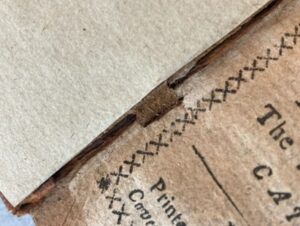
1814 Windsor Primer: Decorated Paper Wrapper Restoration
Minimal treatments are not always possible if a book is intended for regular use. This copy of the Windsor Primer, originally stitched through the side of the textblock and covered with a simple marbled paper wrapper, had been at some point damaged by water, torn in half, and resewn into a limp leather cover to keep the contents together. The textblock was interleaved with archival paper slips in 2008 to keep the relevant page fragments aligned, but even in this state the text was too vulnerable to be accessed by researchers. Treatment necessitated removing the leather wrapper in a manner that preserved as much of the object’s history as possible. The thread was cut from the inside and the thread ends were pasted in place to maintain the visual aesthetic of the overcover. Removing the leather wrapper allowed the textblock to fall to pieces, facilitating surface cleaning, washing, re-sizing, pressing, mending, and collation. The reconditioned textblock was sewn through the fold to allow for smoother opening, but the original bits of side-stitching thread were re-sandwiched into the structure to restore the tactile sensation of that structural terrain. Even in this intensive treatment, great efforts were made to preserve not just the object but also its sensory experience and history of use.
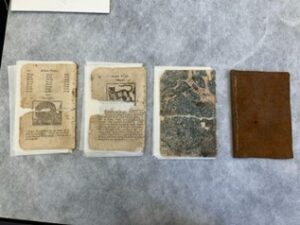
1772 NEP: Faux-scaleboard Historical Rebinding
The same is true for the last project I completed during my internship. The binding on this NEP was totally obliterated, but evidence remained of the original structure (slots for stabbed supports) and access to a later edition of the same work offered some idea of the original binding. Knowledge of scaleboard and other contemporary structures facilitated the design of a replacement binding altered to improve access (sewing through the fold over frayed cords using the original spine notches) while respectful of the original tactile and aesthetic experience (including faux tawed supports, blue paper covering, and exposed ‘wooden’ boards). This treatment managed to preserve the original structural evidence while re-establishing access and even restoring historical information which was lost through neglect and degradation.
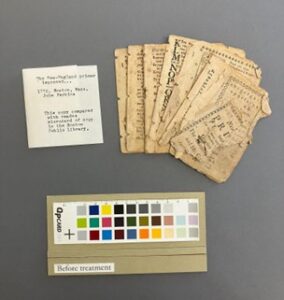
Their idiosyncrasies and unique considerations notwithstanding, the goal of each of these treatments was to facilitate access, allowing more readers to engage with these historical objects and bring their own perspectives to bear on their history and social value as heritage artifacts. From a conservator’s point of view, this is best accomplished when such treatments maintain and even highlight the damage and repairs these books have been subject to. Content, structure, and evidence of use each reveal insights on the intended audience for these objects: they are not finely tooled leather bindings meant to sit on a shelf, but everyday objects subject to heavy use, repair, and alteration over generations. These, in turn, are the stories conservators must strive to recognize, share, and preserve.
Unrecorded Textblock Edge Decoration Style
In closing I offer up a new mystery uncovered over the course of this research: a particular style of textblock edge decoration which, so far as I can tell, has not been recorded or explored in any published literature. While fully colored and sprinkled edges are fairly common for 18th century bindings, the bands of red, blue, green, or brownish black ink found on several bindings are unique in both appearance and the fact that they are apparently exclusive to the NEP. When I first noticed this decoration during a survey at the Library of Congress, I was ready to write it off as personalization by a previous owner. After gathering more data, however, we’ve found 75 examples of this decoration on imprints spanning 100 years, 7 states, and 20 cities. Edge decoration is important because these books were produced at minimal cost and maximum efficiency: the extra time and expense required to decorate these books must have had some financial justification. Was the bright decoration a form of advertising for the NEP, meant to catch the eye of children or parents? A nationalist attempt to distinguish the new American product from English imprints with similar content?
The origins of this style are yet unknown, but it bears some resemblance to the sprinkled band edge decoration on some 16th- and 17th-century German bindings and to some bindings from the collection of Edward Gwynn, a 17th-century English bibliophile known for his personalized bindings. Is the style linked to European bookbinders coming over to the New World and bringing their training and aesthetic sensibilities with them? Might Colonial binders have seen these books and decided to emulate the style themselves? In any case, why was the practice confined to primers? Whatever the reason, it is linked to the global history of the book, and deserves further exploration.
Resources
- American Antiquarian Society (2022) 350969 – The New England Primer. [Catalog Entry]. Available at: https://www.americanantiquarian.org/350969-new-england-primer
- American Antiquarian Society (n.d.) The New England Primer: Perspectives from the Collection. [Virtual Presentation]. Available at: https://www.americanantiquarian.org/virtual-public-program-new-england-primer
- Gundrum, M.; Knoll, J. (2023) Knowledge Before Oratory: A Preliminary Survey of Scaleboard Bindings at the Boston Athenaeum. 51st Annual Conference of the American Institute for Conservation (AIC) [Poster]. Available at: https://www.culturalheritage.org/docs/default-source/publications/annualmeeting/2023-posters/29-knowledge-before-oratory_a-preliminary-survey-of-scalebord-bindings-at-the-boston-athen%c3%a6um—gundrum-and-knoll.pdf
- Miller, J. (2013) “Not Just Another Beautiful Binding: A Typology of American Scaleboard Bindings” in Miller, J. Suave Mechanicals, Volume 1. Ann Arbor: The Legacy Press, pp. 247–315.
- New York Times (1897) A Famous Book—The “New England Primer”. Available at: https://timesmachine.nytimes.com/timesmachine/1897/11/14/105957671.pdf
- Pattison, Todd (2024) “As Good as it Needs to Be: The Myth of Temporary Book Covers in American Book Production, 1700-1850” in Miller, J. (ed.) Suave Mechanicals, Volume 8. Ann Arbor: The Legacy Press.
- Pearson, David (2005) English Bookbinding Styles 1450-1800: A Handbook. New Castle: Oak Knoll Press.
- Rhodes, B. (1995) 18th and 19th Century European and American Paper Binding Structures: A Case Study of Paper Bindings in the American Museum of Natural History Library. Available at: https://cool.culturalheritage.org/coolaic/sg/bpg/annual/v14/bp14-06.html
- Sims, Liam (2018) “Edward Gwynn and his bindings.” Cambridge University Library Special Collections [Blog]. Available at: https://specialcollections-blog.lib.cam.ac.uk/?p=16492
- Wasowicz, Laura (2011) “19th Century American Children’s Book Trade Directory.” American Antiquarian Society. Available at: https://www.americanantiquarian.org/btdirectory.htm
- Wikipedia (2023) ‘The New England Primer’. Available at: https://en.wikipedia.org/wiki/The_New_England_Primer
- Williams, R. (2017) “Scaleboard Wood and Potential Loss Replacement” in Miller, J. (ed.) Suave Mechanicals, Volume 4. Ann Arbor: The Legacy Press.
- Wolcott, R. (2013) Splintered: The History, Structure, and Conservation of American Scaleboard Bindings. The Book and Paper Group Annual 32. Available at: https://cool.culturalheritage.org/coolaic/sg/bpg/annual/v32/bpga32-12.pdf
- Wolff, S. (2012) American Cookery: A Scaleboard Binding. Available at: http://dartmouthpreservation.blogspot.com/2012/06/american-cookery-scaleboard-binding.html
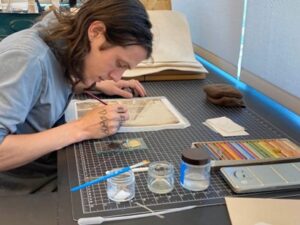 Mitchel Gundrum was the Conservation Intern at AAS in Summer 2023. He began his training in 2017 at the San Francisco Center for the Book, from there earning a diploma in traditional bookbinding techniques from North Bennet Street School in 2021 and an MA in book conservation from West Dean College in 2023. He has previously worked at the US National Archives, the National Park Service, and the Boston Athenaeum, and taught workshops in book repair and related arts at North Bennet Street School, Pyramid Atlantic Art Center, and West Dean College. He is currently the Kress Conservation Fellow at UCLA’s Library Preservation program.
Mitchel Gundrum was the Conservation Intern at AAS in Summer 2023. He began his training in 2017 at the San Francisco Center for the Book, from there earning a diploma in traditional bookbinding techniques from North Bennet Street School in 2021 and an MA in book conservation from West Dean College in 2023. He has previously worked at the US National Archives, the National Park Service, and the Boston Athenaeum, and taught workshops in book repair and related arts at North Bennet Street School, Pyramid Atlantic Art Center, and West Dean College. He is currently the Kress Conservation Fellow at UCLA’s Library Preservation program.

